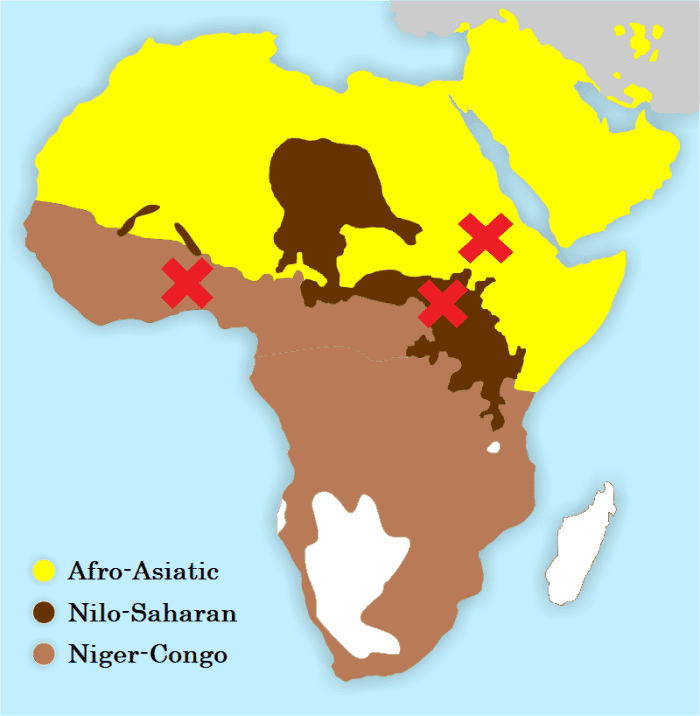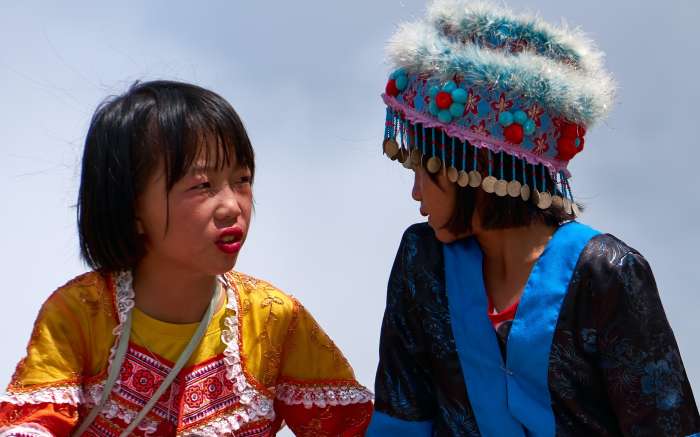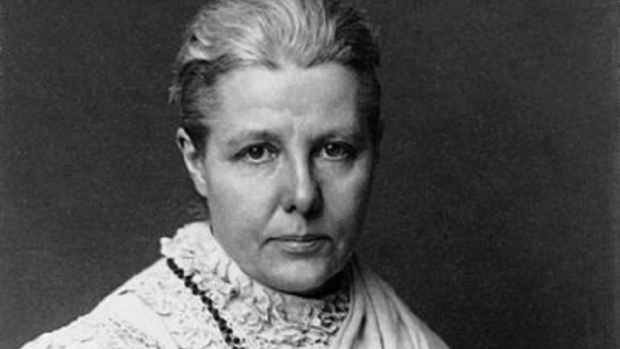The 14 Major Language Families and Their Evolution
What Is a Language Family?
The cultural evolution of human beings is charted by the languages we speak, which can reveal the hidden connections between cultures that have forged our shared traditions, philosophies, and art forms.
Language families map these connections by grouping together languages that share a common root ancestor or proto-language. For example, French and Spanish evolved from Latin, while Hindi and Punjabi evolved from Sanskrit, with both lines inheriting vocabulary from a common "Proto-Indo-European" ancestor.
These relationships are supported by linguistic consistencies, augmentations, and extrapolations, although some scholars use geographical proximity to propose a provisional family (e.g., Amerindian) when linguistic data are lacking.
There are 14 major families that cover most of the world and its ~8,500 languages, although the total number of families is anywhere from 142 to more than 400 (see references).
1. Indo-European
- Speakers: 3.5 billion (46% of Earth's population)
- Languages: 583
- Location of origin: Ukraine and southern Russia
- Time of origin: 4,500 BCE
- Culture of origin: Yamnaya culture (extinct)
The Indo-European language family is the largest in terms of speakers. It is likely to have originated in the ancient Yamnaya culture, whose domestication of the horse facilitated their dissemination of "Proto-Indo-European." An alternative theory proposes that the family spread from Turkey with the development of agriculture.
Evolution of Indo-European Languages
A phylogenetic analysis of Indo-European languages established the family tree below. Many European languages are "Italic" because this branch included Latin, which emerged ~1,000 BCE and was later spread by the Roman Empire. Latin developed into the Romance languages, which include French, Spanish, Italian, and Portuguese.
Celtic and Germanic flourished in northwest Europe, although the Roman expansion confined Celtic to the outer British Isles. Germanic became a major influence after the fall of Rome, giving rise to English, German, and Dutch. However, much of the English language also derives from Latin and French (following the Norman conquest of Britain in 1066).
Other branches include Hellenic (ancient and modern Greek), Indo-Aryan (ancient Sanskrit and modern Hindi-Urdu, Bengali, and Punjabi), Iranian (Farsi, Afghani, and Kurdish), and Balto-Slavic (Russian and most Eastern European languages).
2. Sino-Tibetan
- Speakers: 1.4 billion (18% of Earth's population)
- Languages: 501
- Location of origin: northern China (Yellow River basin)
- Time of origin: 5,000 BCE
- Culture of origin: Yangshao culture (extinct)
Sino-Tibetan is the second largest family by speakers, and about 95% speak Chinese languages. Recent studies suggest that the family originated in ~5,000 BCE in northern China and spread with the development of agriculture, with the Tibetan branch diverging ~4,000 BCE.
Evolution of Sino-Tibetan Languages
The main branches of Sino-Tibetan are shown in the map above. From oldest to newest, these are:
Recommended
- Chinese (brown, 1.3 billion speakers) descended from "Old Chinese" and now includes Mandarin (65.7%), Min (6.2%), Wu (6.1%), Yue (5.6%), Jin (5.2%), Gan (3.9%), Hakka (3.5%), Xiang (3.0%), and others (1%).
- Tibetic (light blue, 6 million speakers) covers an area established by the extinct Tibetan Empire (618–842 CE).
- Karenic (green, 4m speakers) is situated on the hills of the Myanmar-Thailand border.
- Others (red, ~20m speakers) include more than 100 languages from northeast India to the southeastern Himalayas.
- Lolo-Burmese (purple) may be the most recent branch, in which Burmese (33m speakers, Myanmar) is closely related to Loloish (9m, southern China).
3. Afro-Asiatic
- Speakers: 500 million (7% of of Earth's population)
- Languages: 379
- Location of origin: Sudan or Ethiopia
- Time of origin: 18,000–8,000 BCE
- Culture of origin: African hunter-gatherers (pre-Neolithic)
Afro-Asiatic is the oldest confirmed family. Most scholars believe it originated in Africa, based on the diversity of its African languages compared to those in Asia. As Proto-Afro-Asiatic likely evolved before Neolithic agriculture and civilization, there is no known culture of origin.
Evolution of Afro-Asiatic Languages
The most widely-spoken Afro-Asiatic language is Arabic, which belongs to the Semitic branch of the family. The five major branches are:
- Berber, of which Tuareg languages dominate, has largely been replaced by Arabic, but still has ~16m speakers, primarily in northwest Africa (Morocco and Algeria).
- Chadic is spoken in West-Central Africa (Chad and Nigeria) and includes 150 languages, the largest being Hausa with ~72m speakers.
- Cushitic languages number about 30 (the largest are Oromo and Somali) and are spoken in East Africa (Ethiopia, Sudan, Tanzania) by ~70m people.
- Egyptian, or Ancient Egyptian, is a single language appearing ~3,000 BCE. It was completely replaced by Arabic ~1,300 CE.
- Semitic, with 40–80 languages, is the only branch not native to Africa. It includes Akkadian (extinct), Arabic (300m speakers), Hebrew (5m), Aramaic (<1m), and Ethiopian Amharic (25m).
There is no agreement on the order of their branching, although most scholars regard Cushitic as older and Berber as newer.

The major African language families and their possible origins (crosses). The white mainland areas contain smaller families or isolates, while Madagascar is Austric (below).
4. Niger-Congo
- Speakers: 700 million (9% of Earth's population)
- Languages: 1,542
- Location of origin: West Africa (speculative; Blench, 2006)
- Time of origin: 9,000–8,000 BCE (speculative; Blench, 2006)
- Culture of origin: unknown
The Niger-Congo language family is the third largest by number of speakers. It may have originated in West Africa (e.g., Nigeria), with its spread associated with growing use of the bow and arrow.
Evolution of Niger-Congo Languages
The main branch is called "Atlantic Congo" with 600m speakers. It includes the Bantu sub-family, which covers most of South and Central Africa, with 350m speakers and ~500 languages, the largest being Swahili (80m).
Atlantic-Congo also includes several West African languages, including Fula (25m), the 70 Gur languages (20m), Akan (22m, Ghana), and Yoruba and Igbo (50m and 42m, both Nigeria).
The addition of another branch with 100m speakers that includes the 75 "Mande" languages of West Africa (among others) is controversial.
5. Nilo-Saharan
- Speakers: 55 million (0.7% of Earth's population)
- Languages: 206
- Location of origin: South Sudan (speculative; Blench, 2006)
- Time of origin: 16,000 BCE (speculative; Blench 2006)
- Culture of origin: unknown
Nilo-Saharan is a proposed language family because the academic community is divided over whether there is enough linguistic evidence to call it one. Its name comes from its proximity to the River Nile and Sahara desert. Its ancient origin is based on the age of some of its languages, such as Nubian, which still has 1.7m speakers in Egypt and Sudan.
Other significant languages include Maasai (1m, Kenya and Tanzania), Lugbara (1.7m, Uganda and Congo), Songhay (3.2m, Mali and Niger), Kanuri (4m around Lake Chad), and Lou/Dholou (4.4m, Kenya and Tanzania).





